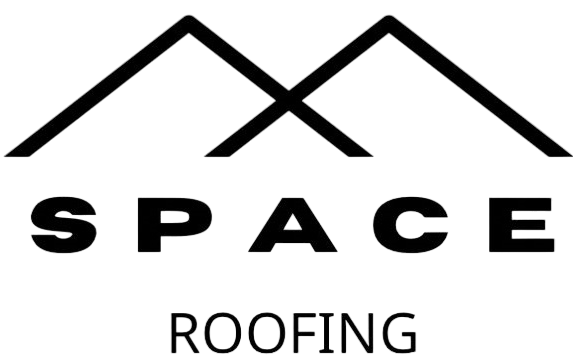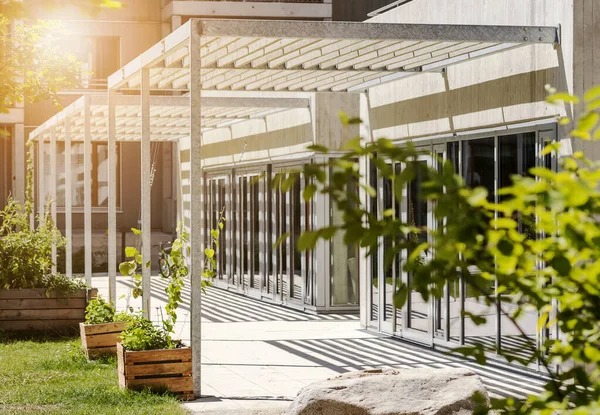When it comes to choosing between asphalt vs metal roofing, homeowners often face a tough decision. Asphalt shingles are cost-effective and familiar, while metal roofing stands out for its durability and efficiency.
If you are comparing based on roof longevity, budget, or energy performance, it is vital to understand the unique strengths of each. Asphalt typically lasts 15–30 years, whereas metal roofs last 40–70 years, according to NRCA. Plus, a StateFarm study suggests metal may reduce cooling costs by 40%. From resale value to maintenance needs, let’s unpack the decision.
Whether you are upgrading a roof in a suburban neighborhood or building a new one in a rural setting, the materials you choose today will shape the comfort, cost, and curb appeal of your home for decades.
First, let’s explore each roofing type’s key features and typical use cases.
What Are the Characteristics of Asphalt and Metal Roofing?
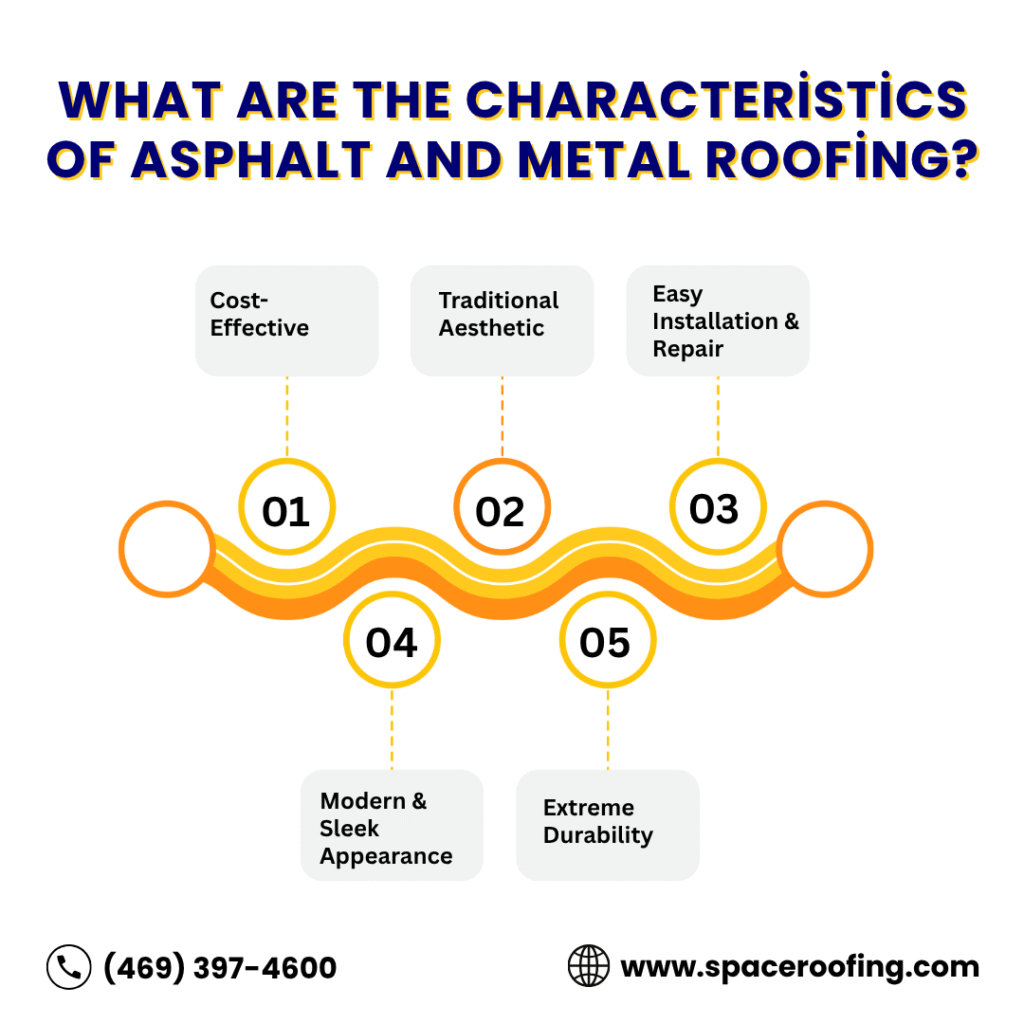
Understanding each material’s core traits helps match roofing style to your home’s needs. Both asphalt shingles and standing seam metal roofs offer viable solutions with distinct benefits.
Asphalt is affordable and widely used, while metal offers superior longevity and heat reflection. Factors like hail resistance, Class 4 impact rating, and color options also influence your decision. Homeowners often compare texture, finish, and warranty coverage when finalizing their choice.
1. Asphalt Shingles
Asphalt shingles are affordable and versatile, covering ~80% of US homes. These shingles include starter strips and underlayment for weatherproofing and can feature a Class 4 impact rating.
Homeowners often choose between 3-tab and architectural styles, each offering different profiles and durability. With an average asphalt shingle lifespan of up to 30 years, they are a reliable, hail-resistant choice.
GAF Timberline and TAMKO Heritage are leading brands in this space, offering a variety in textures and colors. These shingles also allow easy repair and come in shades that blend well with classic or contemporary architecture. Installation is simple and works well in climates where heavy snow and ice aren’t a major concern.
2. Metal Roofing
Metal roofing, durable and energy-efficient, offers lifespan up to 70 years. Options include standing seam panels or corrugated sheets, with gauges influencing thickness and durability.
Many come with cool reflective coatings that reduce UV absorption, boosting your home’s energy profile. This metal roof lifespan advantage makes it a top choice in extreme climates.
Leading styles include interlocking panels and custom finishes, making metal both resilient and aesthetically flexible. It is also fire-resistant, a crucial advantage in wildfire-prone areas, and often qualifies for premium home insurance discounts. Interlocking systems prevent leaks and hold firm during high winds.
How Do Asphalt and Metal Roofing Compare Across Key Factors?
|
Factor |
Asphalt Shingles |
Metal Roofing |
| Lifespan | 15–30 years | 40–70 years |
| Upfront Cost | $4–12 / sq ft | $4–30 / sq ft |
| Maintenance | Replace missing shingles; reseal flashing | Minimal; durable coatings; seal fasteners |
| Energy Efficiency | Standard reflectivity | Reflective coating reduces cooling bills ~40% |
| Weather Resistance | Class 4 hail, wind-rated options | Excellent hail, wind, UV resistance |
| Eco-friendliness | Petroleum-based; limited recyclability | 100% recyclable; sustainable production |
| Resale Value | +62% ROI on re-roofing (shingle resale value) | Potentially higher ROI; buyer appeal |
This matrix clarifies which material suits your priorities, cost-efficiency, longevity, or green credentials. If you are a homeowner looking to balance upfront cost with curb appeal and value appreciation, comparing these categories head-to-head is the most effective way to decide. Each option carries distinct trade-offs, but both serve well depending on your goals.
Who Should Choose Asphalt or Metal Roofing?
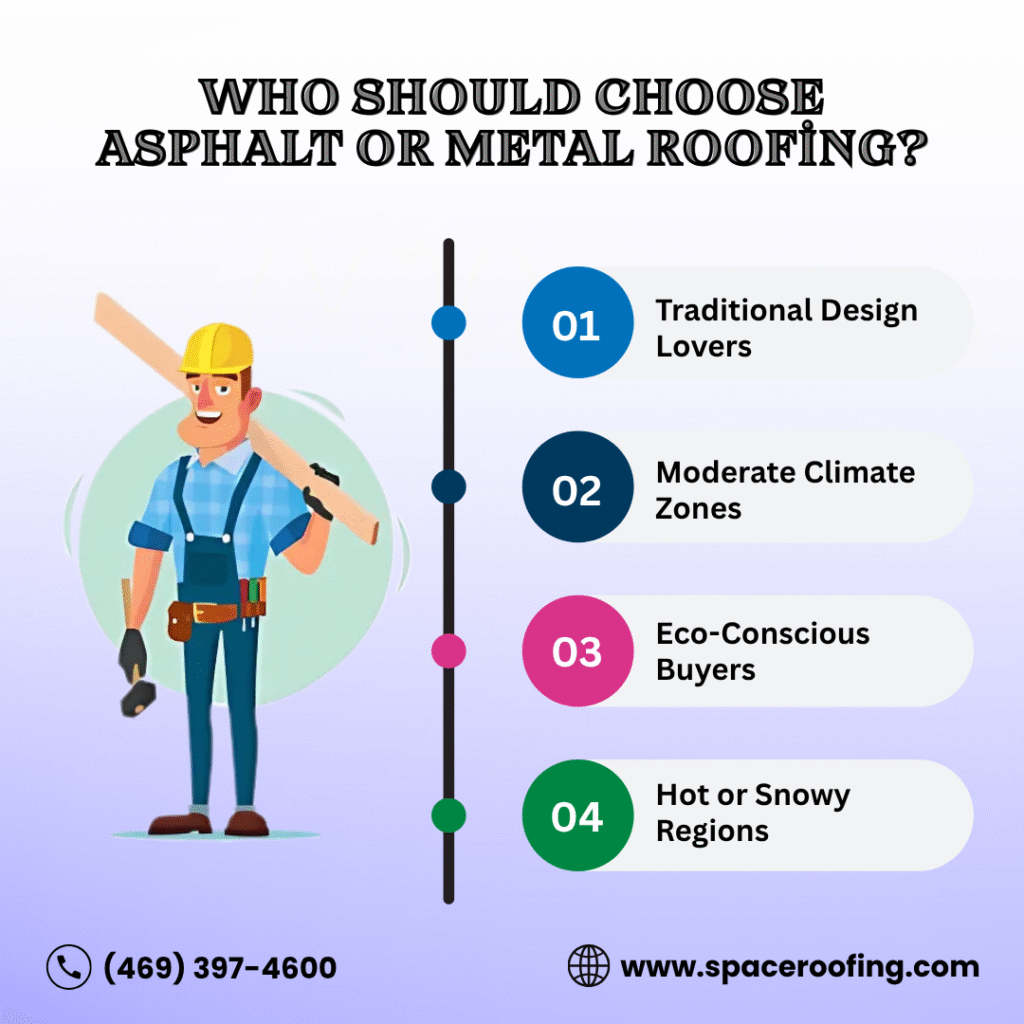
Your climate, style preference, and investment horizon determine your best roof choice. Asphalt is often preferred for its lower upfront cost, especially when roofing ROI matters in the short term.
On the other hand, budget metal roofing makes sense if long-term savings and durability are key. In regions with harsh winters or frequent hail, like Texas, metal is often the best roofing for cold climates due to its superior performance. Consider regional weather trends, resale plans, and local permit regulations before making your final decision.
1. When Asphalt Fits
Perfect for budgets under $10,000, short-term ownership plans, and traditional home designs. It’s a practical choice that balances looks and price. If your property is in an HOA-regulated neighborhood or if you are flipping a house, asphalt is generally a safer and more compliant pick.
2. When Metal Makes Sense
Ideal for homeowners in hail-prone zones, those seeking eco-friendly options, or anyone planning to stay in their home for decades. The roof longevity comparison strongly favors metal for people investing in multi-generational homes or aiming to minimize environmental impact over time.
What Is the Installation Process and Timeline?
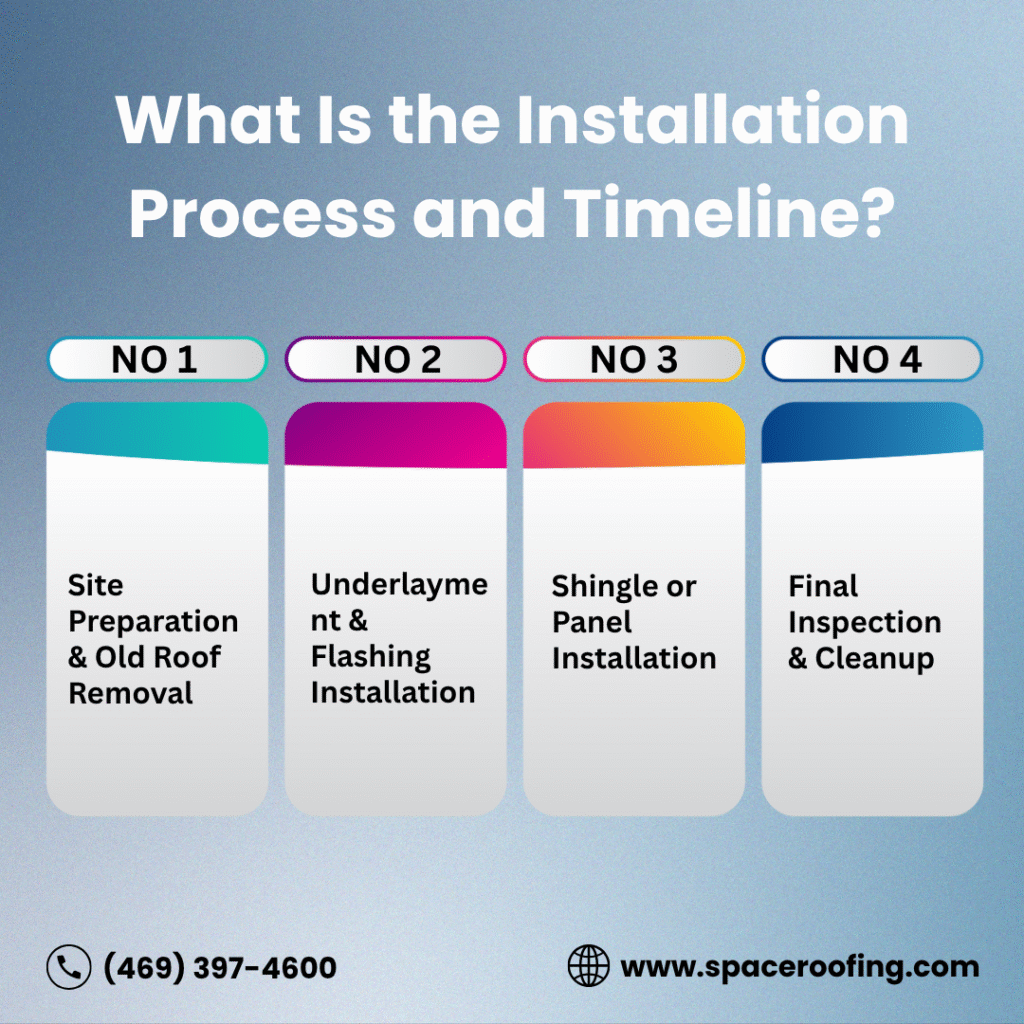
Installation time varies, and you have to understand the process to plan better. Asphalt and metal roofs follow different timelines and involve varying materials and techniques.
Whether you are doing a full tear-off or retrofitting, timelines can be affected by weather and contractor availability. Understanding each phase, from tear-off to final inspection, helps manage expectations and avoid delays.
1. Asphalt Installation Steps & Duration
Asphalt installation usually starts with a full tear-off on day one. Then, underlayment, flashing, and Class 4 shingles are installed over the next two days. The asphalt re-roof process is relatively quick and common in most neighborhoods.
Most homes are completed in 2–3 days, weather permitting. This system fits well into tight construction schedules and requires fewer specialized tools, making it easier to coordinate with other trades on a build site.
2. Metal Installation Steps & Duration
Metal roofing requires a bit more prep. Contractors reinforce the structure, lay underlayment, and then install panels using precise fastener patterns. A full metal roof installation may take 3–5 days, depending on panel complexity.
Proper sealing and finishing ensure compliance with ICC codes and energy guidelines. It is crucial to hire trained installers for metal roofs, as incorrect sealing can lead to condensation or structural compromise. Permit inspections are required in many municipalities and often include detailed checks of fasteners and flashing.
What Are the Costs and ROI of Each Option?
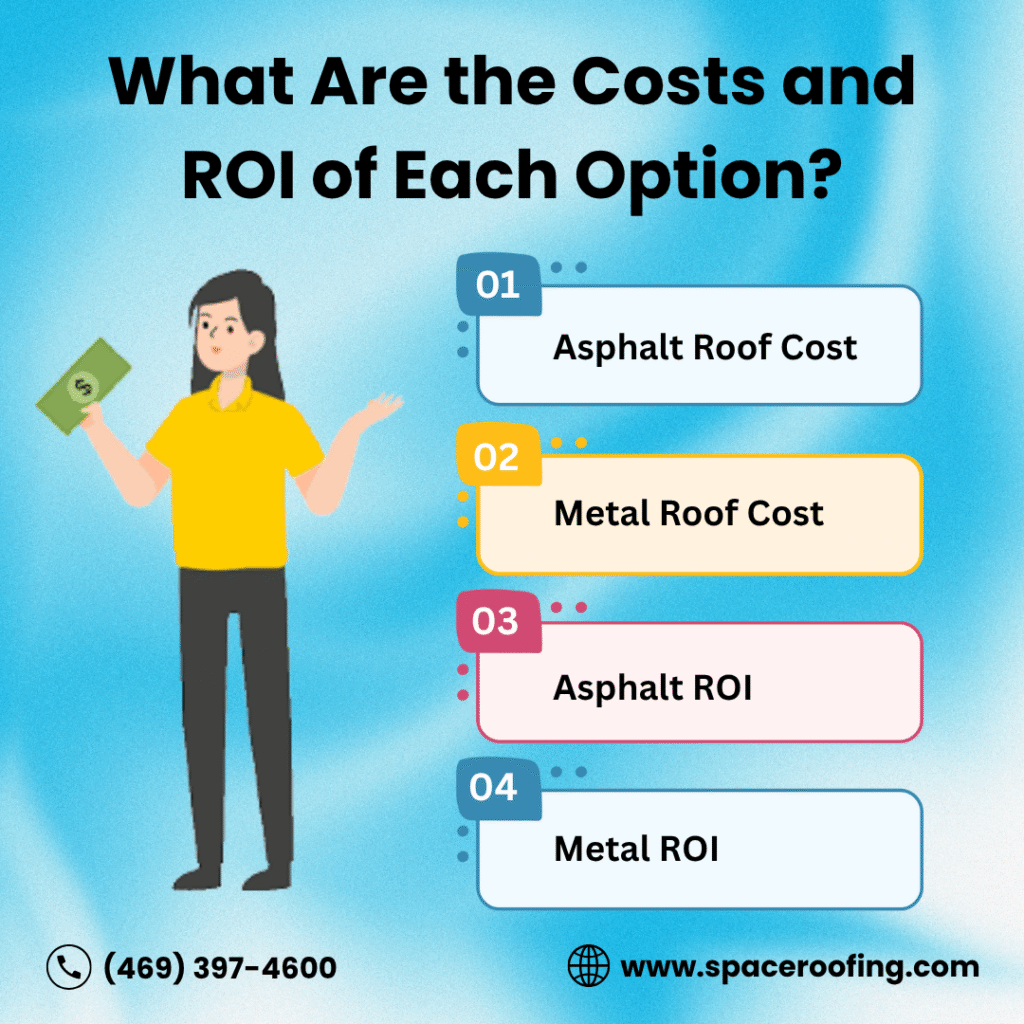
Let’s break down real costs versus long-term value. Roof life-cycle cost is more than just initial expense; it includes energy savings, maintenance, and resale potential. A well-researched roof investment pays off in terms of reduced bills and better equity.
- Total Cost Over Time: Asphalt roofs may need replacement after 25 years, while metal lasts up to 70, making metal more cost-efficient long-term. Factoring in inflation and repeat installation labor, asphalt may be the pricier option across multiple decades.
- Energy & Insurance: Metal reflects sunlight, reducing cooling bills by up to 40%. Some states offer metal roof insurance credit and EnergyStar rebates, which can reduce your total out-of-pocket expense. Asphalt lacks the same level of energy efficiency and may not qualify for such credits.
- Resale Value: Asphalt re-roofing gives a 62% ROI. Metal roofs often increase curb appeal and value further, making them attractive to future buyers. In competitive housing markets, metal may even command a selling premium. Both types can boost home appraisal, but to different degrees.
Both roofing options offer value, but the right choice hinges on your priorities: upfront budget vs. enduring performance. Always consider hidden costs like extended warranties, labor rates, and local material availability.
FAQs About Asphalt vs Metal Roofing
1. Which roofing lasts longest?
Metal roofing lasts the longest, having a lifespan of 50 to 70 years. While asphalt shingles can be a reliable and cheaper option, they have a shorter lifespan, around 30 to 35 years. However, you should select your roofing material based on your requirements.
2. Is metal roofing more expensive upfront?
Yes, metal roofing is more expensive upfront compared to traditional asphalt shingles. This is basically due to the expensive materials and specialized installation required for metal roofs. But it recoups expenses within 10–15 years.
3. Does metal roofing reduce energy bills?
Yes, metal roofing reduces energy bills, cutting costs by nearly 40%. Metal roofs are energy efficient due to their ability to reflect sunlight and heat, which helps to keep homes cooler in the summer and warmer in the winter.
4. Which roofing is better for hailstorms?
Metal roofing is best for hailstorms. It is more likely to withstand hail impacts without significant damage compared to asphalt shingles. Class 4 impact-rated materials offer the highest level of protection against hail.
5. Can I install solar panels on both roof types?
Yes, solar panels can be installed on both roofing types: asphalt and metal roofing. Asphalt shingles require flashing for solar mounts; metal (standing seam) supports clamps without roof penetrations, thereby reducing leak risk and installation time.
